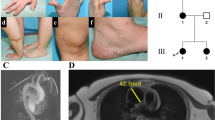Abstract
Familial expansile osteolysis1,2 (FEO, MIM 174810) is a rare, autosomal dominant bone disorder characterized by focal areas of increased bone remodelling. The osteolytic lesions, which develop usually in the long bones during early adulthood, show increased osteoblast and osteoclast activity. Our previous linkage studies mapped the gene responsible for FEO to an interval of less than 5 cM between D18S64 and D18S51 on chromosome 18q21.2–21.3 in a large Northern Irish family3,4. The gene encoding receptor activator of nuclear factor-κ B (RANK; ref. 5), TNFRSF11A, maps to this region. RANK is essential in osteoclast formation6,7. We identified two heterozygous insertion mutations in exon 1 of TNFRSF11A in affected members of four families with FEO or familial Paget disease of bone (PDB). One was a duplication of 18 bases and the other a duplication of 27 bases, both of which affected the signal peptide region of the RANK molecule. Expression of recombinant forms of the mutant RANK proteins revealed perturbations in expression levels and lack of normal cleavage of the signal peptide. Both mutations caused an increase in RANK-mediated nuclear factor-κB (NF-κB) signalling in vitro, consistent with the presence of an activating mutation.
This is a preview of subscription content, access via your institution
Access options
Subscribe to this journal
Receive 12 print issues and online access
$209.00 per year
only $17.42 per issue
Buy this article
- Purchase on Springer Link
- Instant access to full article PDF
Prices may be subject to local taxes which are calculated during checkout



Similar content being viewed by others
References
Osterberg, P.H. An unusual familial disorder of bone: response to calcitonin. in Bone Disease and Calcitonin (ed. Kanis, J.A.) 181– 185 (Armour Pharmaceutical Company, London, 1976).
Osterberg, P.H. et al. Familial expansile osteolysis. A new dysplasia. J. Bone Joint Surg. Br. 70, 255–260 (1988).
Hughes, A.E. et al. Genetic linkage of familial expansile osteolysis to chromosome 18q. Hum. Mol. Genet. 3, 359– 361 (1994).
Hughes, A.E. & Barr, J. Familial expansile osteolysis: a genetic model of Paget's disease. in The Molecular Biology of Paget's Disease (ed. Sharpe, P.T.) 179–199 (RG Landes, Heidelberg, 1996).
Anderson, D.M. et al. A homologue of the TNF receptor and its ligand enhance T-cell growth and dendritic-cell function. Nature 390, 175–179 (1997).
Nakagawa, N. et al. RANK is the essential signaling receptor for osteoclast differentiation factor in osteoclastogenesis. Biochem. Biophys. Res. Commun. 253, 395–400 (1998).
Hsu, H. et al. Tumor necrosis factor receptor family member RANK mediates osteoclast differentiation and activation induced by osteoprotegerin ligand. Proc. Natl Acad. Sci. USA 96, 3540– 3545 (1999).
Enderle, A. & von Gumppenberg, S. [Osteitis deformans (Paget)—or a tarda-type of a hereditary hyperphosphatasia.] Arch. Orthop. Trauma Surg. 94, 127–134 (1979).
Haslam, S.I. et al. Paget's disease of bone: evidence for a susceptibility locus on chromosome 18q and for genetic heterogeneity. J. Bone Miner. Res. 13, 911–917 ( 1998).
von Heijne, G. Signal sequences. The limits of variation. J. Mol. Biol. 184, 99–105 (1984).
Nilsson, I., Whitley, P. & von Heijne, G. The COOH-terminal ends of internal signal and signal-anchor sequences are positioned differently in the ER translocase. J. Cell Biol. 126, 1127–1132 (1994).
Ioannou, P.A. & de Jong, P.J. Construction of bacterial artificial chromosome libraries using the modified P1 (PAC) system. in Current Protocols in Human Genetics (ed. Dracopoli, N.C. et al.) 5.15.1–5.15.24 (John Wiley and Sons, New York, 1996).
Ogilvie, D.J. & James, L.A. End rescue from YACs using the vectorette . in Methods in Molecular Biology Vol. 54 (ed. Markie, D.) 131–138 (Humana Press, Totowa, New Jersey, 1995).
Mitchell, T. & Sugden, B. Stimulation of NF-κ B-mediated transcription by mutant derivatives of the latent membrane protein of Epstein-Barr virus. J. Virol. 69, 2968– 2976 (1995).
Acknowledgements
We thank the clinicians and families for participation; C. Huang, M. Timour, J. Bertles, D. McGibbon and G. Taylor for technical support; N. Nevin, G. Means, J. Derry and D. Cosman for helpful discussions; and the UK Human Genome Mapping Project Resource Centre. S.H.R. was supported by grants from the Wellcome Trust, Arthritis Research Council (UK), the National Association for Relief of Paget's Disease (UK) and the Paget Foundation (USA).
Author information
Authors and Affiliations
Corresponding author
Rights and permissions
About this article
Cite this article
Hughes, A., Ralston, S., Marken, J. et al. Mutations in TNFRSF11A, affecting the signal peptide of RANK, cause familial expansile osteolysis. Nat Genet 24, 45–48 (2000). https://doi.org/10.1038/71667
Received:
Accepted:
Issue Date:
DOI: https://doi.org/10.1038/71667
This article is cited by
-
Targeting Oxidative Stress Markers, Xanthine Oxidase, TNFRSF11A and Cathepsin L in Curcumin-Treated Collagen-Induced Arthritis: A Physiological and COSMO-RS Study
Inflammation (2023)
-
Familial Paget’s disease of bone with ocular manifestations and a novel TNFRSF11A duplication variant (72dup27)
Journal of Bone and Mineral Metabolism (2023)
-
The third case of TNFRSF11A-associated dysosteosclerosis with a mutation producing elongating proteins
Journal of Human Genetics (2021)
-
Paget’s Disease of Bone: Osteoimmunology and Osteoclast Pathology
Current Allergy and Asthma Reports (2021)
-
Genetic disorders associated with the RANKL/OPG/RANK pathway
Journal of Bone and Mineral Metabolism (2021)



